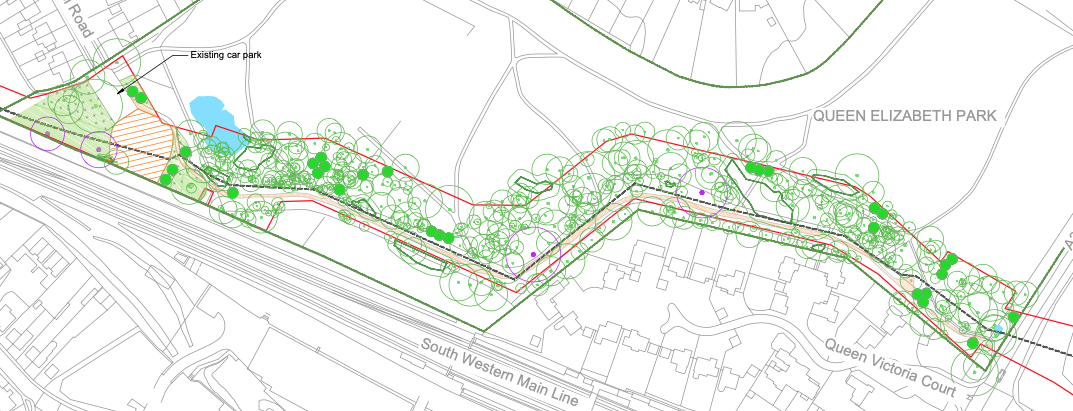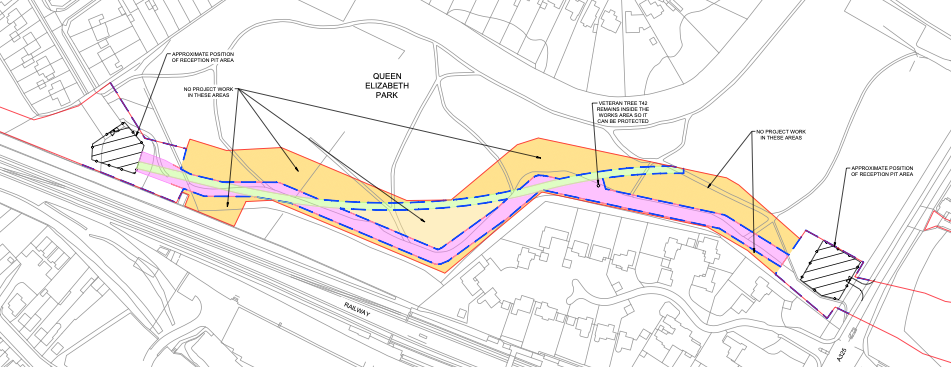DCO Decision
The Development Consent Order for Esso’s Southampton to London Pipeline project was granted by the Secretary of State on 7th October 2020.
Throughout the six month examination of the application, we tried to convince Esso and the Planning Inspectorate that less destructive installation methods should be used within the park. We hoped that Esso would agree not to dig a trench through the roots of our trees, not to dig a deep pit by the A325, not to build two construction compounds and not to close the Cabrol Road car park during their work.
We were hopeful that the Development Consent Order would contain a requirement for the installation technique within the park to be agreed between Esso and Rushmoor Borough Council.
The Planning Inspectorate and the Secretary of State did not include this requirement. Esso’s plans will now go ahead with the risk of significant damage to the park during and after their work.
The decision is extremely disappointing for us, but we will co-operate fully with Esso and their contractors during the project to ensure the park is protected as far as possible during their activities. We also hope to continue to work with Rushmoor Borough Council as a community group to maintain and improve the park.
Below is a summary of why we think the Planning Inspectorate’s recommendation and Secretary of State’s subsequent decision went the way they did, along with an overview of the implications for the park.
When did the Planning Inspectorate become convinced by Esso’s arguments over ours?
The Planning Inspectorate’s Examination Report summarises the arguments and timeline leading to the QEP decision on pages 69-81. Esso did just enough at the final deadline to prevent the DCO requiring Rushmoor Borough Council’s approval for the installation technique.
- Throughout the 6 month examination, right until the last deadline, the Planning Inspectorate were not convinced by Esso’s arguments (sections 5.4.59, 5.4.60, 5.4.61, 5.4.66, 5.4.97, 5.4.106, 5.4.111).
- 5.4.111 shows that they were not convinced that the Deadline 6 revision of the Site Specific Plan for the park was adequate and proposed that the DCO should include a requirement that Rushmoor Borough Council approve the SSP, and therefore the installation technique within the park.
- In 5.4.113 and 5.4.118 they finally conclude that the Deadline 7 revision of the SSP ‘adequately commits the Applicant to a fixed pipeline route, the number of trees to be removed and replacement which is secured through Requirement 17 of the Recommended DCO’.
Why did the Planning Inspectorate recommend in favour of Esso?
There are two reasons why the Planning Inspectorate’s decision went against us:
- Esso’s statements on tree retention and how it would work near trees
- Doubts expressed by Esso about HDD
Esso’s statements on tree retention and works near trees
The Planning Inspectorate had doubts about Esso’s claims on tree retention within the park from the beginning of the examination. These doubts remained until the final deadline, where the Planning Inspectorate considered they had been addressed by Esso’s most recent changes to the Site Specific Plan and the Code of Construction Practice.
The Site Specific Plan does not give clarity on exactly where hand digging will be used or how the pipeline will be lowered into a trench full of tree roots. It does not guarantee that the trees which are retained will be left unharmed in the auger bore area by the A325 or anywhere else within the park.
Doubts expressed by Esso about HDD
The Planning Inspectorate were willing to consider Horizontal Directional Drilling as an alternative to trenching but say that not enough evidence was presented to prove it was feasible.
This is the most harsh and unfair aspect of the decision because it effectively required us to be HDD experts, or find and pay for the services of an expert who could produce a comprehensive and provably workable plan at very short notice. At the start of the examination we didn’t even know what HDD was and it was only late on in the examination that Esso said they would not use this technique, meaning we would have to do the investigation ourselves. It also meant that other trenchless techniques were not considered.
We raised legitimate, quantified and evidenced concerns about Esso’s use of trenching. Esso cast doubt on trenchless installation because they didn’t want to do it. Esso got their way.
What’s in the Site Specific Plan?
Esso’s Site Specific Plan for Queen Elizabeth Park
Last-minute changes to the SSP prevented the Planning Inspectorate from recommending that the final installation method should be agreed with RBC. These changes were submitted at the last deadline, meaning that we did not have a chance to comment on them.
The SSP commits to a specific route for the pipeline - depressingly and dangerously close to the Fairy Tree and numerous other trees in the park. The commitment to a specific route was only added in the final version of the plan and this was an important factor in Esso winning the Planning Inspectorate over (despite the fact the route not shown in great detail — and only on a small scale plan).

Section 3.3 broadly describes what vegetation will be removed and makes reference to Appendix B and C (see below). Interestingly, Esso removed a sentence which reads: ‘It is anticipated that none of the mature trees identified in the park will require removal.’ The Planning Inspectorate were apparently happy with its removal! However it also includes the statement ‘The installation will not require the removal of any mature or veteran trees’, which was also present in earlier versions, so perhaps they considered this to be sufficient.
Appendix B contains a plan showing where Esso is allowed to work in the park. They can work in the white, green and purple areas within the red order limits. They cannot work within the orange/yellow areas without RBC’s approval (section 3.5.1). They will clear all vegetation from within the green, purple and white areas, with the exception of trees. We believe they can trim any trees in, or overhanging those areas without additional approval. The promises of tree retention still seem to be impossible to keep in the A325 auger pit area, given the nature of the work they will be doing there.

Appendix C lists the trees which Esso is allowed to remove. There are 30 of them. Esso state that any tree not in that list will be retained. However, they can remove any tree, even if it is not on the list, with RBC’s consent. The problem is that we don’t know how many other trees Esso will say they need to remove during the construction work what reasons they will give for doing so, e.g. damage, safety, an assessment that they are in poor condition. We also do not know how long RBC will have agree to their removal before Esso do it anyway, or how readily RBC will agree.
What’s in the Code of Construction Practice?
Esso’s Code of Construction Practice
Section 2.11 describes how Esso’s contractors will work near trees. The Planning Inspectorate consider that this is sufficient to protect the trees in the park during trenching. It is not possible for us to share their view on this.
Summary
The Planning Inspectorate seem to say the choice was between the quantified effects of trenching and the unquantified effects of HDD. We think it is quite evident that the effects of trenching have not been quantified by Esso and are likely to do a lot of damage to the park, both in the short and long term. It is clear that more time was needed to show that HDD or other trenchless techniques are feasible and less damaging, but the Planning Inspectorate’s recommendation did not permit this. The damage done by the auger bore area seems to have been largely ignored, as do the inaccuracies in Esso’s plans which they relied on to justify their work.
More Details
If you want more background about the project, the pages which we previously published are below.
June 2020:
September 2019: